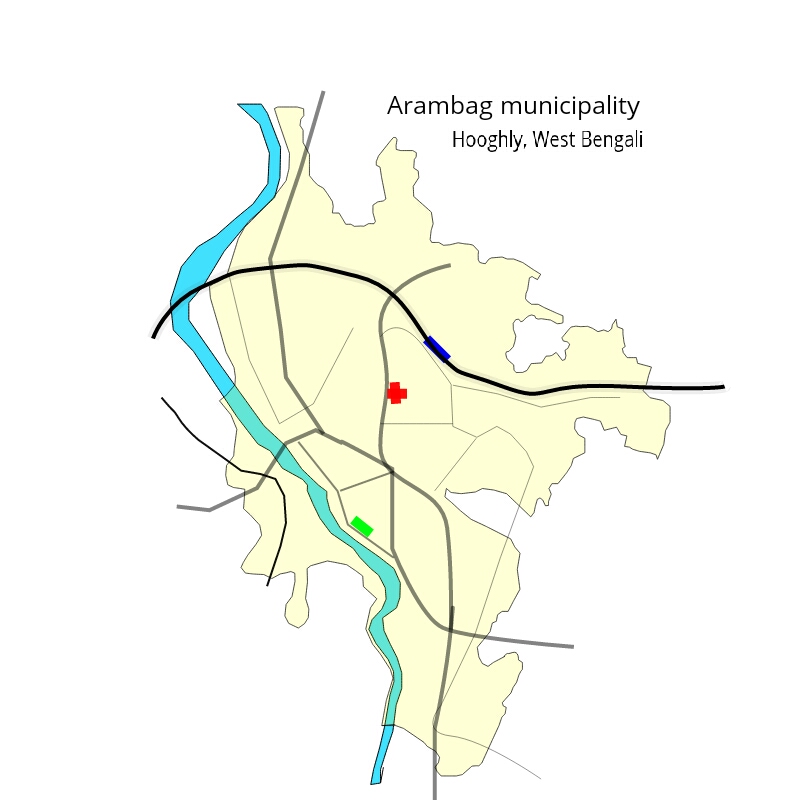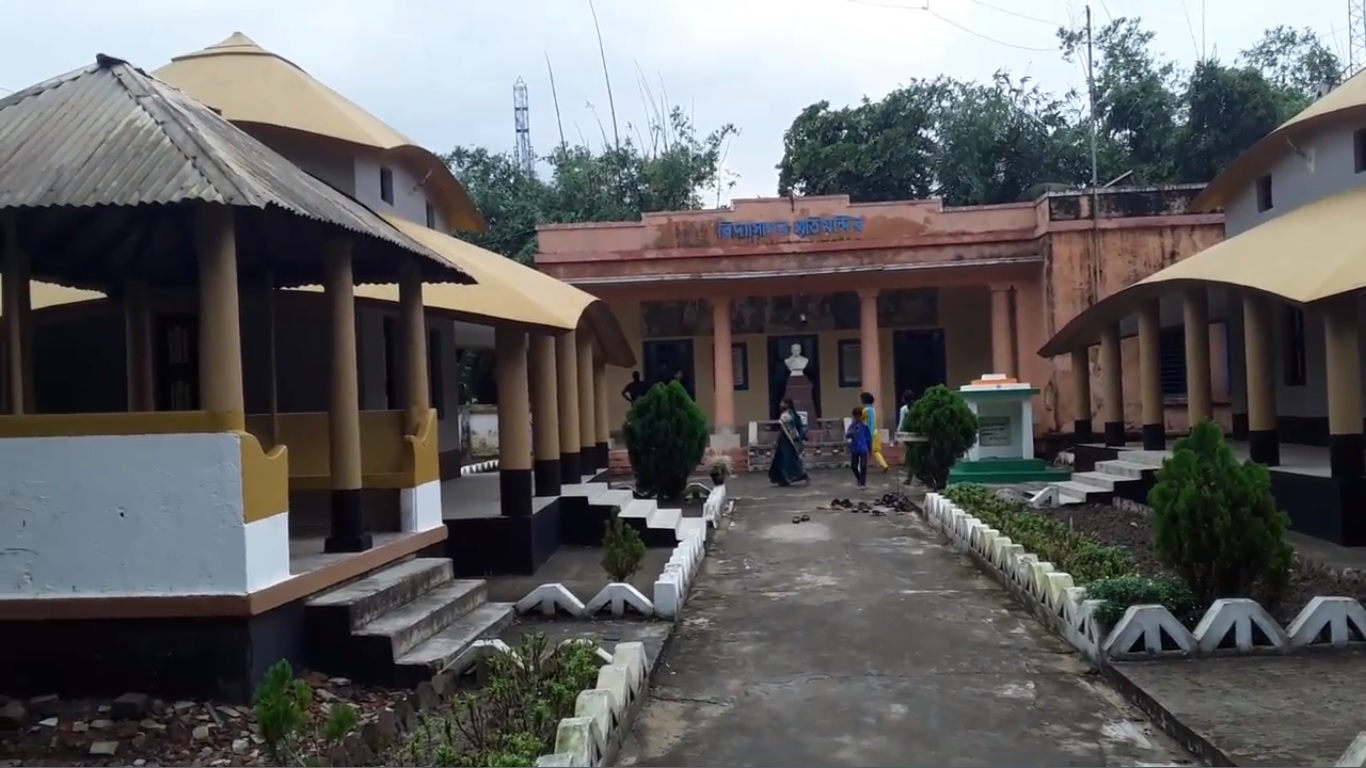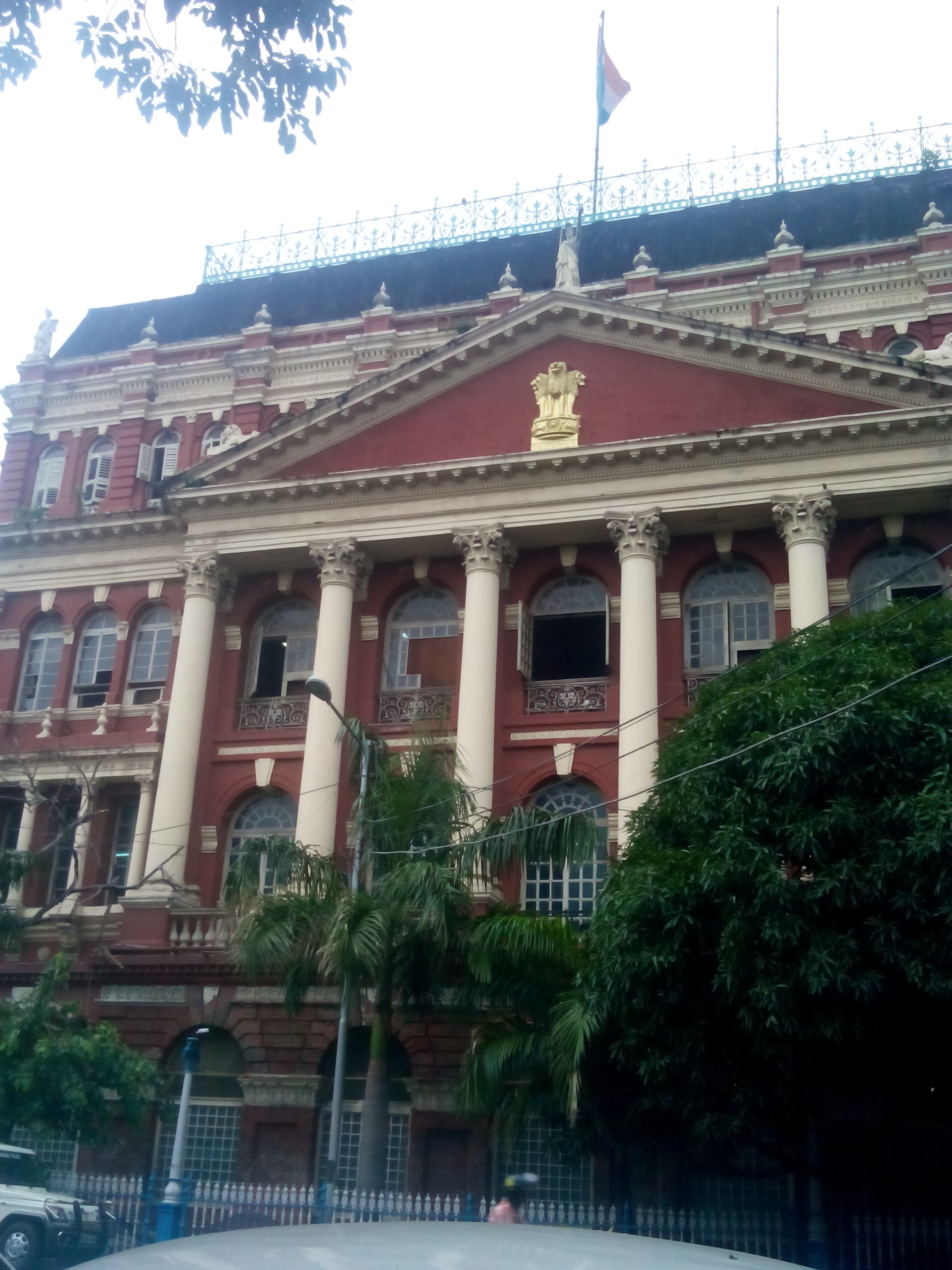|
Nagendranath Chattopadhyay
Nagendranath Chattopadhyay was a Sanskrit scholar and noted grammarian who lived in the early 20th century at Salepur village, approximately five miles from the sub-divisional headquarters in Arambagh in Hooghly district, West Bengal, India. Academic career Chattopadhyay passed the entrance examination and graduated with a B.A. (Hons) degree from the University of Calcutta. One of his classmates was the writer Khagendranath Mitra. Teaching career Nagendranath joined the 'Bhagabati Vidyalaya' at Birsingha village, appointed as the headmaster of the institution established by Ishwarchandra Vidyasagar for female education, but he left after a short time. It is reported that at the time the institute was a mere mud thatched and straw-shedded hut. One Nabagopal Das, the SDO (Sub-Divisional Officer) of Arambagh Subdivision arranged for his joining as the headmaster at Arambagh High English School, where he served for the rest of his career, spanning more than 40 years. There is a ... [...More Info...] [...Related Items...] OR: [Wikipedia] [Google] [Baidu] |
Arambagh
Arambagh also known as Arambag is a town and a municipality in Hooghly district in the state of West Bengal, India. It is the headquarters of Arambagh subdivision. Geography Location Arambagh is located at . It has an average elevation of 15 metres (118 feet). The town is situated on the link Road (state highway-2) 81Km north-west of Kolkata, 27 Km north-west of Tarakeswar, 39 Km south-east of Bardhaman. It is located on the bank of the Dwarakeswar River. Area overview The Arambagh subdivision, presented in the map alongside, is divided into two physiographic parts – the Dwarakeswar River being the dividing line. The western part is upland and rocky – it is extension of the terrain of neighbouring Bankura district. The eastern part is flat alluvial plain area. The railways, the roads and flood-control measures have had an impact on the area. The area is overwhelmingly rural with 94.77% of the population living in rural areas and 5.23% of the population ... [...More Info...] [...Related Items...] OR: [Wikipedia] [Google] [Baidu] |
Hooghly District
Hooghly district () is one of the districts of the Indian state of West Bengal. It can alternatively be spelt ''Hoogli'' or ''Hugli''. The district is named after the Hooghly River. The headquarters of the district are at Hooghly-Chinsura (''Chuchura''). There are four subdivisions: Chinsurah Sadar, Srirampore, Chandannagore, and Arambagh. History The district of Hooghly derived its name from the town of Hooghly on the west bank of the Hugli River about 40 km north of Kolkata. This town was a major river port for trade in India before colonialism. The district has thousands of years of rich heritage as part of the Bengali kingdom of Bhurshut. The first European to reach this area was the Portuguese sailor Vasco da Gama. In 1536 Portuguese traders obtained a permit from Sultan Mahmud Shah to trade in this area. In those days the Hooghly River was the main route for transportation and Hooghly served as an excellent trading port. Within a few decades, the town of Hoog ... [...More Info...] [...Related Items...] OR: [Wikipedia] [Google] [Baidu] |
West Bengal
West Bengal (, Bengali: ''Poshchim Bongo'', , abbr. WB) is a state in the eastern portion of India. It is situated along the Bay of Bengal, along with a population of over 91 million inhabitants within an area of . West Bengal is the fourth-most populous and thirteenth-largest state by area in India, as well as the eighth-most populous country subdivision of the world. As a part of the Bengal region of the Indian subcontinent, it borders Bangladesh in the east, and Nepal and Bhutan in the north. It also borders the Indian states of Odisha, Jharkhand, Bihar, Sikkim and Assam. The state capital is Kolkata, the third-largest metropolis, and seventh largest city by population in India. West Bengal includes the Darjeeling Himalayan hill region, the Ganges delta, the Rarh region, the coastal Sundarbans and the Bay of Bengal. The state's main ethnic group are the Bengalis, with the Bengali Hindus forming the demographic majority. The area's early history featured a succession ... [...More Info...] [...Related Items...] OR: [Wikipedia] [Google] [Baidu] |
India
India, officially the Republic of India (Hindi: ), is a country in South Asia. It is the seventh-largest country by area, the second-most populous country, and the most populous democracy in the world. Bounded by the Indian Ocean on the south, the Arabian Sea on the southwest, and the Bay of Bengal on the southeast, it shares land borders with Pakistan to the west; China, Nepal, and Bhutan to the north; and Bangladesh and Myanmar to the east. In the Indian Ocean, India is in the vicinity of Sri Lanka and the Maldives; its Andaman and Nicobar Islands share a maritime border with Thailand, Myanmar, and Indonesia. Modern humans arrived on the Indian subcontinent from Africa no later than 55,000 years ago., "Y-Chromosome and Mt-DNA data support the colonization of South Asia by modern humans originating in Africa. ... Coalescence dates for most non-European populations average to between 73–55 ka.", "Modern human beings—''Homo sapiens''—originated in Africa. Then, int ... [...More Info...] [...Related Items...] OR: [Wikipedia] [Google] [Baidu] |
University Of Calcutta
The University of Calcutta (informally known as Calcutta University; CU) is a Public university, public collegiate university, collegiate State university (India), state university in India, located in Kolkata, West Bengal, India. Considered one of best university, state research university all over India every year, CU has topped among India's best universities several times. It has 151 affiliated undergraduate colleges and 16 institutes in Kolkata and nearby areas. It was established on 24 January 1857 and is the oldest multidisciplinary and European-style institution in Asia. Today, the university's jurisdiction is limited to a few districts of West Bengal, but at the time of establishment it had a catchment area, ranging from Lahore to Myanmar. Within India, it is recognized as a "Five-Star University" and accredited an "A+" grade by the National Assessment and Accreditation Council (NAAC). The University of Calcutta was awarded the status of "Centre with Potential for Exce ... [...More Info...] [...Related Items...] OR: [Wikipedia] [Google] [Baidu] |
Ishwarchandra Vidyasagar
Ishwar Chandra Vidyasagar CIE ( bn, ঈশ্বর চন্দ্র বিদ্যাসাগর; 26 September 1820 – 29 July 1891), born Ishwar Chandra Bandyopadhyay, was an Indian educator and social reformer of the nineteenth century. His efforts to simplify and modernise Bengali prose were significant. He also rationalised and simplified the Bengali alphabet and type, which had remained unchanged since Charles Wilkins and Panchanan Karmakar had cut the first (wooden) Bengali type in 1780. He was the most prominent campaigner for Hindu widow remarriage, petitioning the Legislative Council despite severe opposition, including a counter petition (by Radhakanta Deb and the Dharma Sabha) which had nearly four times as many signatures. Even though widow remarriage was considered a flagrant breach of Hindu customs and was staunchly opposed, Lord Dalhousie personally finalised the bill and the ''Hindu Widows' Remarriage Act'', ''1856'' was passed . Against child marriage,e ... [...More Info...] [...Related Items...] OR: [Wikipedia] [Google] [Baidu] |
John Nesfield
John Collinson Nesfield (14 August 1836 – 28 June 1919) served in various roles as an educator in British India and was for some time curate of St Michael's Church, Highgate, London. He wrote numerous books, of which his works on grammar were particularly influential. Life John Nesfield was born in 1836 and was the son of a cleric from Wiltshire, England. He attended Highgate School, Highgate Grammar School from 1852-1855 and later taught there from 1859-1864. He became a postmaster (holder of a senior scholarship) at Merton College, Oxford, Merton College at the University of Oxford. There he earned a BA degree in 1860 and was later Master of Arts (Oxbridge and Dublin), promoted to an MA in 1862. Nesfield became the curate of St Michael's Church, Highgate, in Middlesex. He began his career in British India in January 1867. There he served initially as a professor at Presidency College, Kolkata, Presidency College and Krishnagar Government College, both in the Bengal Pr ... [...More Info...] [...Related Items...] OR: [Wikipedia] [Google] [Baidu] |
Chief Minister Of West Bengal
The Chief Minister of West Bengal is the representative of the Government of India in the state of West Bengal and the head of the executive branch of the Government of West Bengal. The chief minister is head of the Council of Ministers and appoints ministers. The chief minister, along with their cabinet, exercises executive authority in the state. The governor appoints the chief minister, whose council of ministers are collectively responsible to the assembly. On 17 August 1947, the British Indian province of Bengal was partitioned into the Pakistani province of East Bengal and the Indian state of West Bengal. Since then West Bengal has had eight chief ministers, starting with Prafulla Chandra Ghosh of the Indian National Congress (INC) party as the premier. A period of political instability followed—West Bengal witnessed three elections, four coalition governments and three stints of President's rule between 1967 and 1972—before Siddhartha Shankar Ray of the INC serv ... [...More Info...] [...Related Items...] OR: [Wikipedia] [Google] [Baidu] |
Prafulla Chandra Sen
Prafulla Chandra Sen (10 April 1897 – 25 September 1990) was an Indian politician and freedom fighter. He was the Chief Minister of West Bengal from 1962 to 1967. Background Prafulla Chandra Sen was born in the village Senhati in the Khulna District of Bengal on 10 April 1897 in a Vaidya family. Most of his childhood was spent in Bihar, Eastern India. He started his education in Bihar and passed the entrance exam to attend the R. Mitra Institute in Deoghar. He then went on to receive a Bachelor of Science degree from Scottish Church College in Calcutta. After graduating, he joined an accounting firm and aspired to move to England in order to become an articled clerk. His ambitions changed upon hearing Mahatma Gandhi's speech at the Calcutta session of the Congress Party in 1920. Influenced by Gandhi's speech, Sen abandoned his plans of studying abroad and rallied to Gandhi's call for a mass non-cooperation movement against the British. In 1923, Sen shifted to the area of Ara ... [...More Info...] [...Related Items...] OR: [Wikipedia] [Google] [Baidu] |
Rabiranjan Chattopadhyay
Rabiranjan Chattopadhyay (30 September 1940 – 2 November 2021) was an Indian politician and the erstwhile Minister for the departments of Technical Education and Training, Science and Technology and Biotechnology in the Government of West Bengal. He was also an MLA, elected from the Bardhaman Dakshin constituency in the 2011 West Bengal state assembly election Assembly election was held in Indian state of West Bengal in 2011 to elect the members of West Bengal Legislative Assembly as the term of the incumbent government was about to expire naturally. It was held in six phases between 18 April and .... He was re-elected again in the 2016 West Bengal Legislative Assembly election. References 1940 births 2021 deaths State cabinet ministers of West Bengal Trinamool Congress politicians from West Bengal People from Purba Bardhaman district {{WestBengal-politician-stub ... [...More Info...] [...Related Items...] OR: [Wikipedia] [Google] [Baidu] |
People From West Bengal
A person (plural, : people) is a being that has certain capacities or attributes such as reason, morality, consciousness or self-consciousness, and being a part of a culturally established form of social relations such as kinship, ownership of property, or legal obligation, legal responsibility. The defining features of personhood and, consequently, what makes a person count as a person, differ widely among cultures and contexts. In addition to the question of personhood, of what makes a being count as a person to begin with, there are further questions about personal identity and self: both about what makes any particular person that particular person instead of another, and about what makes a person at one time the same person as they were or will be at another time despite any intervening changes. The plural form "people" is often used to refer to an entire nation or ethnic group (as in "a people"), and this was the original meaning of the word; it subsequently acquired its us ... [...More Info...] [...Related Items...] OR: [Wikipedia] [Google] [Baidu] |






_1938.jpg)